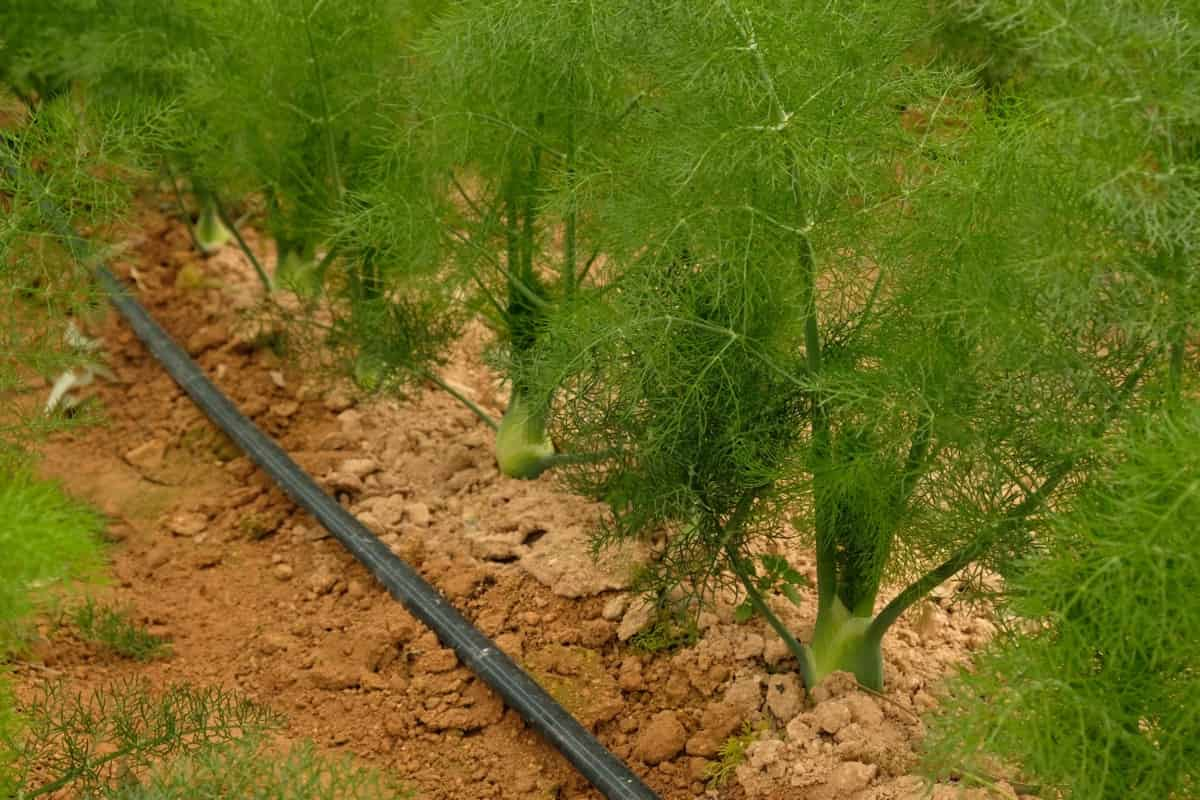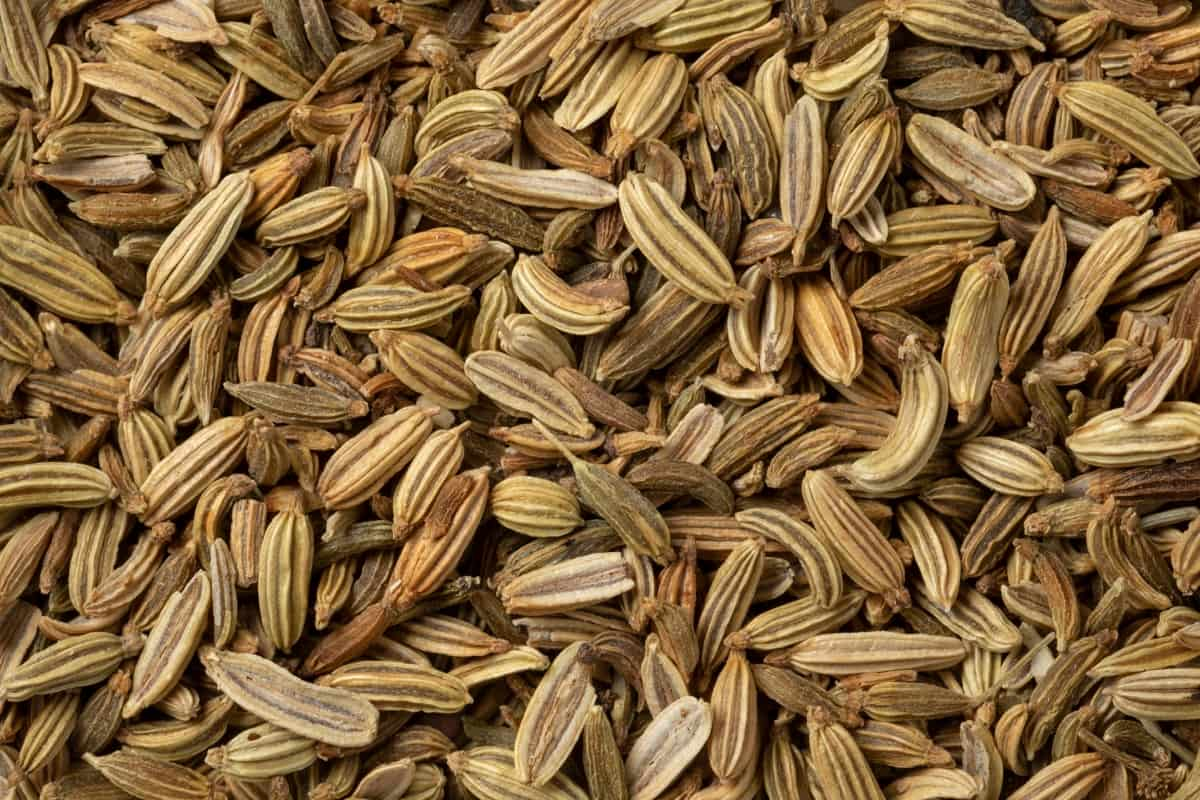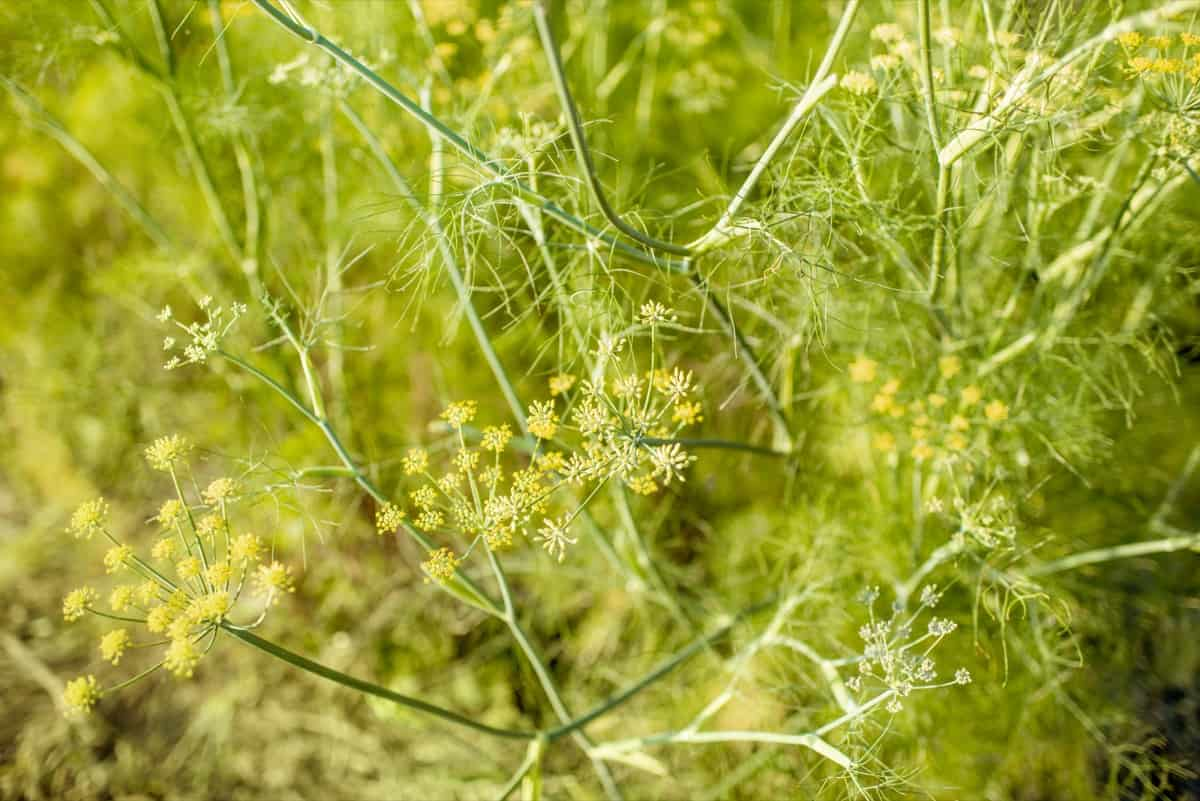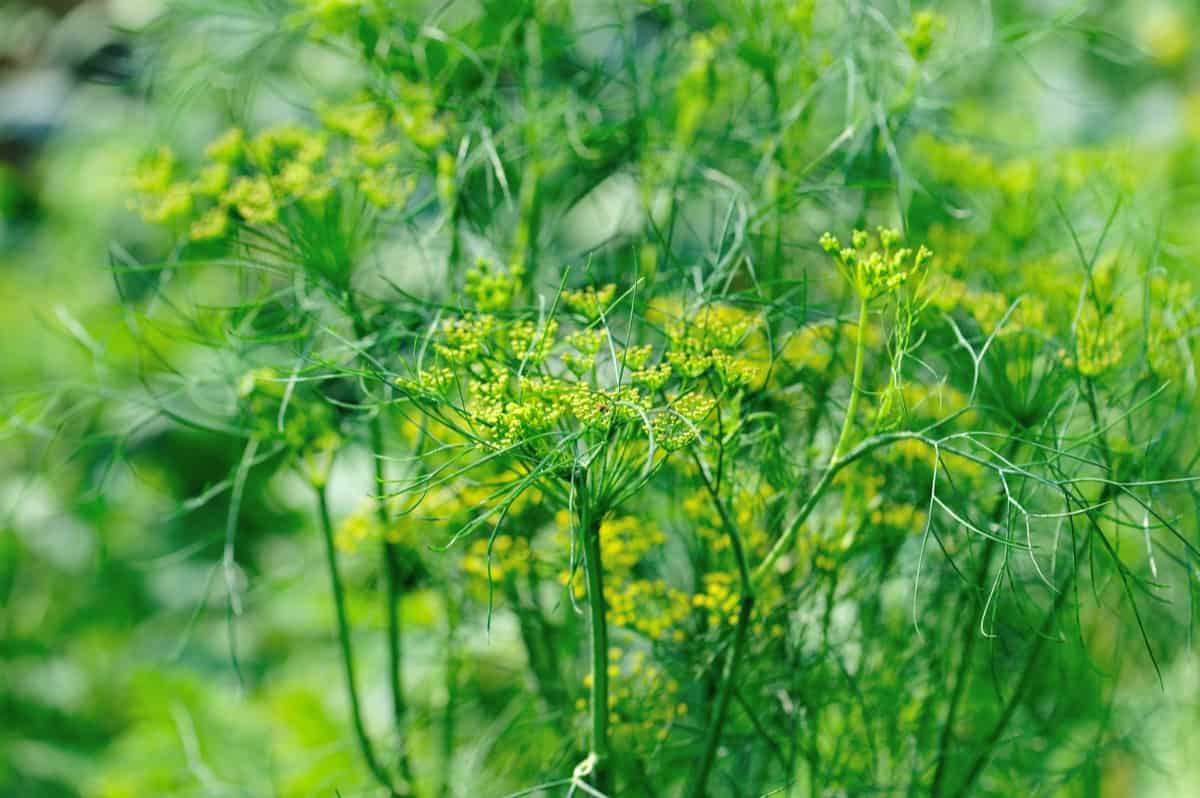Fennel, with its delicate feathery leaves and aromatic flavors, is a versatile herb that offers many benefits for the garden and the kitchen. Fennel is incredibly easy to grow. It requires minimal care and can thrive in various climates. Whether you have ample space in your backyard or just a small container on your balcony, Fennel can adapt to different growing conditions. Moreover, Fennel adds beauty to any garden with its tall stalks covered in vibrant green foliage. It makes for an attractive addition alongside other herbs and flowers.

How to Grow and Care for Organic Fennel
Step-by-step Guide to Planting Organic Fennel from Seeds
You’ll need to prepare the soil to plant organic Fennel from seeds. Choose a sunny spot in your garden, or use containers if space is limited. Fennel prefers well-drained soil with a pH level between 5.5 and 7.0. Once your soil is prepared, it’s time to sow the Fennel seeds. Create shallow furrows about half an inch deep, spacing them around 12 inches apart. Place two to three seeds in each furrow.
After sowing the seeds, cover them lightly with soil and gently water the area. Keep the soil consistently moist but not oversaturated. When seedlings reach about two inches tall, thin them out by removing weaker ones, leaving only one healthy plant per group of seeds. As your Fennel plants grow, provide regular care and maintenance, such as watering when needed, keeping weeds under control, supporting taller varieties, if necessary (such as staking), and protecting against pests naturally using organic methods.
Best Organic Soil Mix for Growing Fennel in Containers
When growing Fennel in containers, having the right soil mix is essential for its success. Start with a base of high-quality potting soil. Look for a blend that contains ingredients like compost, peat moss, and perlite to ensure good drainage. Add well-aged compost or worm castings to enrich the soil with beneficial microorganisms and nutrients. To improve drainage further, incorporate a handful of sand or fine gravel into the mix.
Consider adding some vermiculite or coconut coir to help retain moisture without causing waterlogged conditions. Sprinkle in a slow-release organic fertilizer specifically formulated for vegetables or herbs. This organic soil mix provides your container-grown Fennel with all the necessary nutrients while maintaining proper moisture levels and drainage capacity. Regularly monitor your plants’ needs by checking their moisture levels and adjusting watering accordingly.
How to Care for Organic Fennel in Raised Beds
First, make sure to choose a sunny spot for your raised bed. Fennel loves full sun and needs at least 6-8 hours of direct sunlight daily. Next, prepare the soil by adding compost or well-rotted manure. This will help improve the fertility and structure of the soil, providing a nutrient-rich environment for your Fennel plants. When planting your Fennel seedlings, space them about 12-18 inches apart. Water them thoroughly after planting and keep the soil moist throughout their growth.
In case you missed it: Fennel Gardening for Beginners, How To Start

Mulching around your Fennel plants will help retain moisture levels in the soil and suppress weed growth. Use organic mulch, making sure not to cover the base of the plant too closely. Regularly monitor your Fennel plants for any signs of pests or diseases. Aphids and caterpillars can be common problems for Fennel but can be managed organically using insecticidal soap or neem oil sprays.
To promote healthy growth, fertilize your Fennel plants with an organic fertilizer high in nitrogen every 4-6 weeks during their growing season. Avoid over-fertilization, as this can lead to excessive foliage growth at the expense of bulb development. Remember to harvest your mature bulbs when they reach about 3-5 inches in diameter. Cut them off at ground level using a sharp knife or shears. Regular harvesting encourages new bulb formation and prolongs the overall productivity of your Fennel plants.
Companion Plants for Organic Fennel to Enhance Growth
When growing organic Fennel, choosing the right companion plants can enhance its growth and overall health. One excellent companion plant for Fennel is dill. These two herbs share similar growing conditions and pest-repellent properties, but planting them together can also deter harmful insects like aphids and spider mites. Plus, their aromatic presence adds a delightful fragrance to your garden.
Another great choice is chamomile. This delicate flower attracts beneficial pollinators and is a natural insect repellent against pests such as nematodes and cabbage loopers. Planting chamomile near your Fennel can help protect it from potential threats while promoting biodiversity in your garden.
Additionally, pairing Fennel with calendula or marigold flowers provides numerous benefits. These vibrant blooms attract pollinators like bees and butterflies, which aid in cross-pollination of the flowers and the Fennel plant. Moreover, marigolds are known for repelling harmful insects like aphids and whiteflies. Consider including vegetables like tomatoes or lettuce alongside your Fennel plants. These leafy greens provide shade for the soil around the base of the Fennels’ roots while creating a visually appealing garden bed layout.
In case you missed it: How to Grow and Care for Organic Fenugreek: Planting Instructions

Tips for Pruning and Harvesting Organic Fennel Bulbs
When pruning the Fennel, removing any dead or yellowing leaves is best. These leaves detract from the plant’s appearance and can harbor pests and diseases. Removing them improves air circulation around the plant and reduces fungal infection risk. As for harvesting Fennel bulbs, timing is crucial. The bulbs should be firm and fully developed before picking them. To harvest the bulbs, use a sharp knife or garden shears to cut them off at ground level. Be careful not to damage neighboring plants or disturb their roots during this process.
Organic Fertilizers for Nourishing Fennel Plants Naturally
One of the best organic fertilizers for Fennel is compost. Made from decomposing organic matter, such as kitchen scraps and yard waste, compost enriches the soil with nutrients like nitrogen, phosphorus, and potassium. Add a compost layer around the base of your Fennel plants every few weeks during the growing season.
Another excellent option is worm castings. Rich in beneficial microorganisms and plant-friendly nutrients, worm castings give your Fennel plants a nutrient boost while improving soil structure. Mix them into the top layer of soil or brew them into a liquid fertilizer by steeping them in water for several days. Seaweed-based fertilizers are highly recommended for those who promote robust growth and flowering in their Fennel plants.
Common Pests and Diseases of Organic Fennel and Their Organic Management
A common pest that affects Fennel is aphids. These tiny insects feed on the sap, causing stunted growth and distorted foliage. To manage aphids organically, you can introduce beneficial insects like ladybugs or lacewings to prey on them. Another troublesome pest for Fennel is the caterpillar. These voracious eaters can quickly defoliate your plants if left unchecked. One natural way to control caterpillars is by using Bacillus thuringiensis, a naturally occurring bacteria specifically targeting these pests.
Fungal diseases are also potential threats to organic Fennel. To prevent fungal infections, ensure proper air circulation around your plants by spacing them adequately. A preventative fungicide made from ingredients like neem oil or baking soda can also help fend off fungal attacks. By staying vigilant and implementing these organic management techniques for pests and diseases in your Fennel garden, you can ensure healthy growth without compromising sustainability or endangering other beneficial organisms in your ecosystem.
Watering Schedule for Organic Fennel in Different Climates
Fennel plants require regular deep watering to keep the soil consistently moist in hotter and drier climates, such as Mediterranean regions. This helps prevent the plants from drying out and ensures their healthy growth. Watering should be done early or late in the evening to avoid evaporation. On the other hand, in cooler and wetter climates, overwatering can lead to root rot and other fungal diseases. It’s important to only water when necessary and allow the soil to dry between waterings.
In case you missed it: How to Grow and Care for Organic Dill: Planting Instructions

How to Propagate Organic Fennel from Root Divisions
Propagating organic Fennel from root divisions is a great way to expand your Fennel garden without having to rely solely on seeds. This method involves separating the roots of an established Fennel plant and replanting them in new locations. To start, choose a mature Fennel plant with strong, healthy roots. Dig around the plant base and gently lift it out of the ground, careful not to damage the roots. Once you have lifted the plant, carefully separate the clump of roots into smaller sections using a clean knife or garden shears.
Each divided section should have at least one healthy root system attached. Ensure that each division has enough foliage to support growth once replanted. Next, prepare your planting area by loosening the soil and adding compost or organic matter for improved drainage and fertility. Dig holes large enough to accommodate each divided section with plenty of room for its root system to spread. Place each division in its respective hole, making sure that it is planted at approximately the same depth as it was previously growing. Continue watering regularly as needed throughout their establishment period.
How To Grow Fennel from Cuttings
Growing Fennel from cuttings is a great way to propagate this aromatic herb without relying on seeds. First, select a healthy Fennel plant that you want to take the cutting from. Look for a sturdy stem with several leaves attached to it. Next, carefully snip off a 4–6-inch stem section using clean pruning shears or scissors. Remove any lower leaves so that only the top few remain.
In case you missed it: How to Grow and Care for Organic Hyssop: Planting Instructions

Moisten the soil slightly before inserting the cutting into it. Gently insert the bottom end of the cutting into the soil, ensuring that at least two nodes are buried beneath the surface. Firmly press down around the base of the cutting to secure it in place. Place the pot in a warm location where it gets bright but indirect sunlight throughout the day. Keep an eye on moisture levels and water as needed, ensuring not to overwater as this can cause rotting. Within 2-3 weeks, you should start seeing new growth emerging from your Fennel cutting.
Growing Fennel Indoors
Growing Fennel indoors can be a rewarding experience, allowing you to enjoy this aromatic herb all year round. Whether you have limited outdoor space or want the convenience of having fresh Fennel at your fingertips, growing it indoors is a great option. To start, choose a spot in your home where your Fennel plants will receive at least six hours of direct sunlight daily. Fennel also requires well-draining soil, so use a high-quality potting mix for proper drainage.
When planting Fennel seeds indoors, sow them about 1/4 inch deep in small pots or seed trays filled with the potting mix. Keep the soil moist but not waterlogged as the seeds germinate and sprout. Once the seedlings are grown a few inches tall, transplant them into larger containers to allow room for their taproots to develop.
In case you missed it: How to Grow and Care for Organic Chives: Planting Instructions

Indoor-grown Fennel should be watered regularly but sparingly – aim for evenly moist soil without overwatering. It’s also important to provide adequate air circulation around your plants by placing them in an area with good ventilation. Look for common pests, such as aphids or mites, that could infest your indoor Fennel plants. To manage these pests organically, try spraying diluted neem oil on affected areas or introducing beneficial insects like ladybugs or lacewings.
Conclusion
Growing and caring for organic Fennel can be a rewarding experience for both novice and experienced gardeners. With its unique flavor, versatility in culinary applications, and various health benefits, it’s no wonder why Fennel is a popular addition to home gardens. Growing organic Fennel requires some attention but offers numerous rewards.
- How to Grow Tomatoes Organically at Home: A Comprehensive Guide
- Organic Gardening on a Budget: Low-Cost Methods and Materials
- Gongura Seed Germination and Planting Methods
- Cabbage Seed Germination and Selection
- Broccoli Seed Germination and Selection
- Asparagus Seed Germination and Variety Selection
- Seasonal Flower Gardening: Best Practices for Spring, Summer, Fall, and Winter
- How to Grow Hibiscus from Flower
- Plantation Ideas for Home Decoration: A Beginners Guide
- Flower Garden Designs and Layouts for Beginners
- Planting and Spacing Techniques in Papaya: A Beginner’s Guide
- Growing Gold: Essential Techniques for Planting Pineapples
- How to Make Kalanchoe Plant Bushy: Home Remedies and Solutions
- 11 Reasons Why Your Gardenia is Not Blooming: Home Remedies and Solutions
- Eco Elegance: The Guide to Designing a Drought-Tolerant Landscape
- Gardening on a Slope: Strategies for Hillside Landscaping
- Nourish and Flourish: Top Organic Mulches for Thriving House Plants
- Everything You Want to Know about Indian Mogra Flower: Discover Uses and Growing
- Green Thumb Success: Expert Tips for Cultivating Greenhouse Pumpkins All Year Round
- Maximize Growth & Flavor: The Ultimate Guide to Companion Planting in Herb Gardens
- How to Control Rhododendron Problems Naturally: Home Remedies and Organic Ways to Fix Them
- Natural Magic: The Remarkable Benefits of Cinnamon for Plants
- Best Steps to Revive Dying Tulip with Natural and Organic Treatment
- 10 Reasons Why Your Angel Trumpet is Not Blooming: Remedies and Treatment
- How to Fix Periwinkle Leaf and Flower-Related Problems: Natural Remedies and Solutions
- How to Fix Zinnias Leaf and Flower Problems: Discover Natural and Home Remedies
- Organic Steps to Induce Lemon Tree Flowers: A Comprehensive Guide
- Bloom Booster: Crafting the Perfect Homemade Bougainvillea Fertilizer
- Optimizing Growth: A Guide to Applying NPK Fertilizer for Potted Plants
- 10 Best Homemade Fertilizers for Rubber Plant: DIY Recipes and Application Method
- How to Boost Female Pumpkin Flowers: Effective Steps for More Flowers and High Yields
- Transform Your Indoor Garden: Top Benefits of Pink Salt for Houseplants
- 10 Best Homemade Fertilizers for Peacock Plants (Calathea): Easy DIY Guide
- Unlock Blooms: 9 Reasons Why Your Potted Chrysanthemum is Not Blooming
- 8 Reasons Why Your Potted Hibiscus is Not Blooming: Fix it with Simple Solutions
- Unlock Blooms: 9 Key Reasons Your Potted Frangipani Won’t Flower